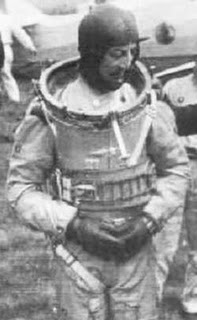Armstrong limit facts for kids
The Armstrong limit is a special height in the sky. Above this height, the air pressure is so low that water boils at your normal body temperature. This means that if you were exposed to this low pressure without protection, the liquids in your body, like your tears or saliva, would start to boil.
If a person goes above the Armstrong limit without proper protection, they would quickly pass out. Their body would stop working properly, and they could die in about a minute, unless the pressure was brought back to normal.
On Earth, this limit is about 18 to 19 kilometers (around 62,000 feet) above sea level. At this height, the air pressure is very low, about 16 times less than the pressure at sea level.
The Armstrong limit is named after Harry George Armstrong, a United States Air Force General. He was the first person to understand how dangerous this low pressure could be for humans.
Contents
What Happens to Body Fluids?
At or above the Armstrong limit, any body fluids that are exposed to the air will boil. This includes things like your saliva (spit), tears, and even the liquids in your lungs. However, the blood inside your veins and arteries (your circulatory system) will not boil. This is because your blood vessels keep the blood under pressure.
To survive above this limit, you need a special full-body pressure suit. Without one, no amount of oxygen would keep you alive for more than a few minutes. One report from NASA described what happened when a person was briefly exposed to a near-vacuum. The person later said that their last memory before passing out was the saliva on their tongue starting to boil.
Your body temperature is normally about 37 degrees Celsius (98.6 degrees Fahrenheit). At the Armstrong limit, the air pressure is so low that water boils at this exact temperature. This pressure is about 6.3 kilopascals (kPa), which is about 1/16th of the normal air pressure at sea level.
Why We Need Oxygen Below the Armstrong Limit
Even below the Armstrong limit, humans often need extra oxygen to avoid hypoxia. Hypoxia means your body isn't getting enough oxygen. Most people start needing extra oxygen when they are above 4,500 meters (about 15,000 feet).
Commercial airplanes keep the air pressure inside their cabins much higher. They usually keep it at a level that feels like you are no higher than 2,400 meters (about 8,000 feet) above sea level.
For smaller planes, pilots must use extra oxygen if they fly above 3,800 meters (about 12,500 feet) for more than 30 minutes. They must use oxygen at all times if they fly above 4,300 meters (about 14,000 feet). Passengers also need oxygen if the plane goes above 4,500 meters (about 15,000 feet). Skydivers usually jump from heights below 4,500 meters, so they don't normally need extra oxygen.
History of High-Altitude Flight
The Armstrong limit is a clear, natural boundary for how high humans can go without special protection. Before this limit was fully understood, pilots wore pressure suits to avoid hypoxia at lower altitudes.
For example, in 1936, Francis Swain of the Royal Air Force flew to 15,230 meters (about 50,000 feet) while wearing a pressure suit. Two years later, Italian pilot Mario Pezzi set an altitude record of 17,083 meters (about 56,000 feet). He also wore a pressure suit, even though he was still below the Armstrong limit.
Today, modern military jets like the F-22 and F-35 can fly at 18,000 meters (about 60,000 feet) or higher. Pilots flying these planes wear a special "counter-pressure garment." This is like a G-suit that also helps them at high altitudes.
If the cockpit of one of these planes loses pressure, the oxygen system quickly gives the pilot extra oxygen at a higher pressure. The special suit also inflates to press on the pilot's body. This helps prevent damage to the lungs and body from the low pressure until the pilot can fly down to a safer height.
Images for kids
See also
 In Spanish: Límite de Armstrong para niños
In Spanish: Límite de Armstrong para niños




